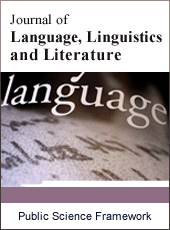Journal of Language, Linguistics and Literature
Articles Information
Journal of Language, Linguistics and Literature, Vol.1, No.5, Oct. 2015, Pub. Date: Oct. 19, 2015
Semiotics of Everyday Life Cultural Structures
Pages: 170-174 Views: 3304 Downloads: 2714
[01]
Marina Yu. Ryabova, Translation Department, Kemerovo State University, Kemerovo, Russia.
The paper deals with linguistic analysis of cultural structure semiotics in the space of everyday life language. The goal of the analysis of everyday life discourse is to discover communicative regularities in the context of quotidian communication on the basis of such research methods as metalinguistics, communication, semiotic analyses and cognitive linguistic description. The research is conducted within the discourses of polycode (also called creolized) texts in The New Yorker (2015). The result of this approach was to offer an account of characteristic features of a quotidian discourse such as visualization as a basic semiotic principle of language semiosis. The iconic (visualization) technique in discourse expresses itself in a creolized text, i.e. a polycode text functioning in mass media communication. We analyzed several types of creolization within a text: repetition, additive, emphatic, appositive, integrative and visual centered texts. So, we have presented evidence that a creolized text is a complex sign which combines verbal and iconic information into a structural, meaningful and functional whole with a unique pragmatic force.
Everyday Life Discourse, Quotidian, Cultural Structures, Mass Communication, Visualization, Iconism, Creolized Text, Polycode Text
[01]
Anisimova, E., 2003: Lingvistica Texta I Mezhkulturnaya Kommunicatsya (na materiale creolizovannykh textov) [Russian]. [Text Linguistics and Crosscultural Communication]. M: «Akademia». 128 p.
[02]
Bourdieu, P., 1979: La Distinction: Critique Sociale du Jugement de Gout. Paris: Les Editions de Minuit. 672 p.
[03]
Bouvier, P., 1989: Le Travail au Quotidien, Demarche Socio-antropologique. Paris: PUF, 190 p.
[04]
Certeau, M. de, 1984: The Practice of Everyday life. Berkeley: Univ. of California Press. 204 p.
[05]
Goffman, Erving, 1959: The Presentation of Self in Everyday Life. N Y: Anchor, 259 p.
[06]
Kasavin, I. N, Schavelev, S. P., 2004: Analis Povsednevnosty [Russian]. [The Analysis of Everyday Life]. M.: Kanon+, 432 p.
[07]
Ross, Kristin, 1997: The Art of the Everyday: the Quotidian in Post-war French Culture. /Ed. By Linn Gumpert. N.Y.: New York Univ. Press, pp.19-31.
[08]
Telminov, G. N., 2009: Internet-Reklama Kak Vyd Creolizovannogo Texta [Russian]. [Internet Advertizing as a Type of Creolized Text]. In: Voprosy Philosophii. M.: Vestnik Nizhegorodskogo Universiteta. 2009, No 5, pp. 300-304.
[09]
Vijk, K., 2011: Formirovanie Znachenij v Povsednevnoj Zhizni: Rol Structur Kultury v Individualnom Soznanii [Russian]. [The Formation of Meanings in Everyday Life: the Role of Cultural Structures in Individual Mind]. In: Voprosy Philosophii. M., 2011. No 10. Pp. 167-176.
[10]
Waldenfels, Bernhard, 1990: Alltag als Schmelztiegel der Rationaltat. In: Des Stachel des Fremden. Frankfurt/Main, 1990, 3 Aufl.1998, S.189-203.
[11]
Wilson, Bee, 2013: The Pleasures of Reading Recipes. In: http://www.newyorker.com/books/page-turner/the-pleasures-of-reading- recipes (2015.07.26).

ISSN Print: 2381-7054
ISSN Online: 2381-7062
Current Issue:
Vol. 6, Issue 1, March Submit a Manuscript Join Editorial Board Join Reviewer Team
ISSN Online: 2381-7062
Current Issue:
Vol. 6, Issue 1, March Submit a Manuscript Join Editorial Board Join Reviewer Team
| About This Journal |
| All Issues |
| Open Access |
| Indexing |
| Payment Information |
| Author Guidelines |
| Review Process |
| Publication Ethics |
| Editorial Board |
| Peer Reviewers |


